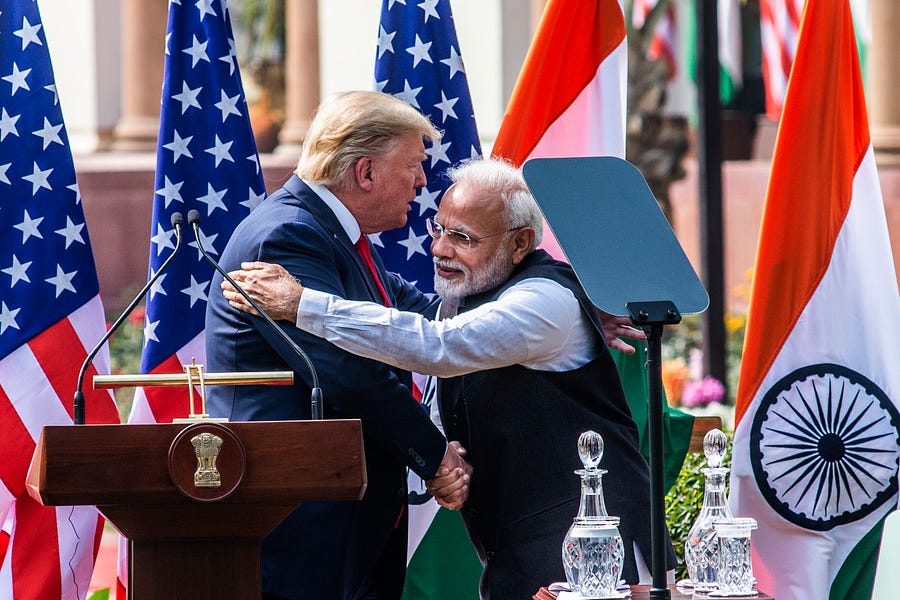A once in a decade series of events in the Asia-Pacific region have conspired to bring about closer ties between America’s most important allies in the Asia-Pacific. Regardless of who wins the election in November, the U.S. has an opportunity to expand this emerging alliance to include other areas of potential cooperation beyond nominal defense ties.
Back in 2007, Japanese Prime Minister Shinzo Abe sought to bring together his country, the United States, Australia, and India with a security arrangement that serve as a bulwark against Chinese expansion in the Indo-Pacific. From the U.S. perspective, key supporters included Vice President Dick Cheney and Republican presidential candidate Sen. John McCain. These efforts fizzled in 2008, but in 2017 the the Trump administration began—quietly and with little fanfare—to reknot the undone defense ties among the nations. The grouping known as the Quadrilateral Security Dialogue was relaunched that year. Analysts in all four countries often refer to it simply as “the Quad.”
China’s increasingly assertive behavior in territorial disputes is causing concern across the Indo-Pacific from Ladakh to Japan’s Senkaku Islands. The governments in all four countries have also taken notice of China’s behavior in the South China Sea where it has militarized a series of artificial islands along one of the world’s busiest maritime transit corridors. Internally, China’s behavior toward Hong Kong or minority groups like the Uighurs is just as worrying.
Earlier this summer, China and India—Asia’s two most substantial nuclear powers—decided to fight it out with sticks and stones. The very real clashes in Ladakh left at least 20 Indian soldiers dead and scores injured in the deadliest fighting between the two countries since the Sino-Indian War of 1962. It was just another sign that China was trying to take advantage of the global disarray caused by the pandemic that started within its very own borders.
In the aftermath of the recent Sino-Indian clashes, Australia signed a joint agreement that will include collaboration on several issues in early June. The new Mutual Logistics Support Arrangement links Australia and India in a comprehensive strategic partnership (CSR)—a status that India already had in its relations with the other members of the Quad as well as Indonesia and Vietnam.
“This will allow the Indian Navy to extend its deployment to the southern tip of the Indian Ocean. Both the militaries are developing interoperability, and this further agreement advances that,” Sameer Patil, a fellow at the Indian think tank Gateway House and a former member of India’s intelligence community tells The Dispatch.
Both countries have military installations on island chains that are crucial to the geography of the Indo-Pacific. India’s Andaman and Nicobar Islands are strategically located to the west of the straits of Malacca. These waterways have long been vital to global trade.
“Whoever is Lord of Malacca has his hand on the throat of Venice,” Tome Pires, a Portuguese apothecary wrote in the 16th century. It is just as vital to global trade today.
Potentially, Australia’s Coco’s Islands provide a similar overwatch over Lombok and Suda straits. It remains to be seen how the rekindled ties develop.
In early July, Japan announced it would now begin sharing intelligence with India and Australia on an equal footing with the United States.
Some history: In September 2007 for the first and only time, all four nations participated in the Malabar Exercise, which originated in 1992 as a bilateral exercise with India and the United States. Perhaps in order to assuage Chinese a single Singaporean vessel also participated. Yet, Beijing watched nervously as the nations conducted the Indian Ocean’s largest naval wargame ever.
However, the Quad soon collapsed over a reticence to deepen the alliance along with political changes in the region notably in Australia. In February 2008, Australian Foreign Minister Stephen Smith’s announced that Australia would not support possible further quadrilateral discussions in a joint event with the Chinese foreign minister. According to U.S. diplomatic cables obtained by WikiLeaks the announcement done without consultation and described as one of the “Significant blunders” of Prime Minister Kevin Rudd’s government.
That announcement, coupled with a decision by the Rudd government to re-consider uranium sales to India soured relations between the two nations and Australia was not invited to the next Malabar Exercise.
But the shift in Australian policy toward India means the former could join as a permanent member as early as 2021 (since this year’s exercise will probably not take place due to the pandemic.)
Growing concerns about China is helping to review the Quad is a trend the next administration should encourage. The Quad met five times between 2017-2019 in some capacity including a first ever meeting of all foreign ministers under the Quad grouping on the sidelines of the 2019 United Nations general assembly in New York.
Earlier this year a joint event featuring the Quad nations and Vietnam, New Zealand, and South Korea was held virtually between the governments to coordinate their response to the pandemic.
That conference aside, it is not in America’s interest to turn the Quad into a new “Pacific Charter,” à la a neo-NATO in Asia. Such concerns also impacted the earlier iteration of the Quad. If NATO offers any lesson, it is the larger such a grouping, the more unwieldy it becomes. India’s relationship with Russia, a long-time partner, could also be a cause for future concern.
We should not rush to turn “the Quad” into “a squad.” Instead, we should remain committed to the growth of this new grouping and to actively build ties among its members.
These should not solely be military ties, however. Indeed, the recent agreement between Australia and India includes a long list of areas of cooperation from environmental issues to India’s effort to join the United Nations security council.
China’s increasingly aggressive behavior in the Indo-Pacific is cause for concerns, but the Quad offers the region’s security architecture four legs to stand on.
Photograph by Pradeep Gaur/Mint/Getty Images.






Please note that we at The Dispatch hold ourselves, our work, and our commenters to a higher standard than other places on the internet. We welcome comments that foster genuine debate or discussion—including comments critical of us or our work—but responses that include ad hominem attacks on fellow Dispatch members or are intended to stoke fear and anger may be moderated.
With your membership, you only have the ability to comment on The Morning Dispatch articles. Consider upgrading to join the conversation everywhere.